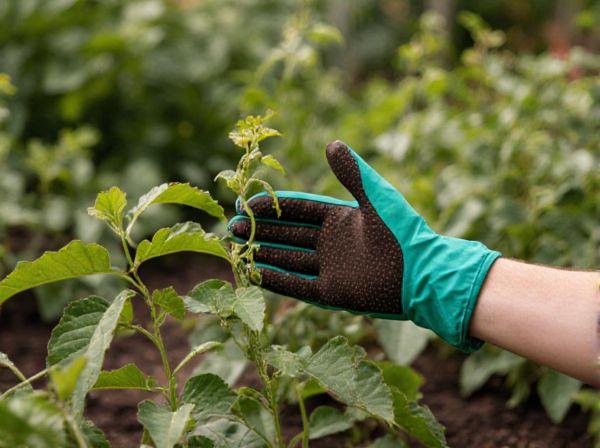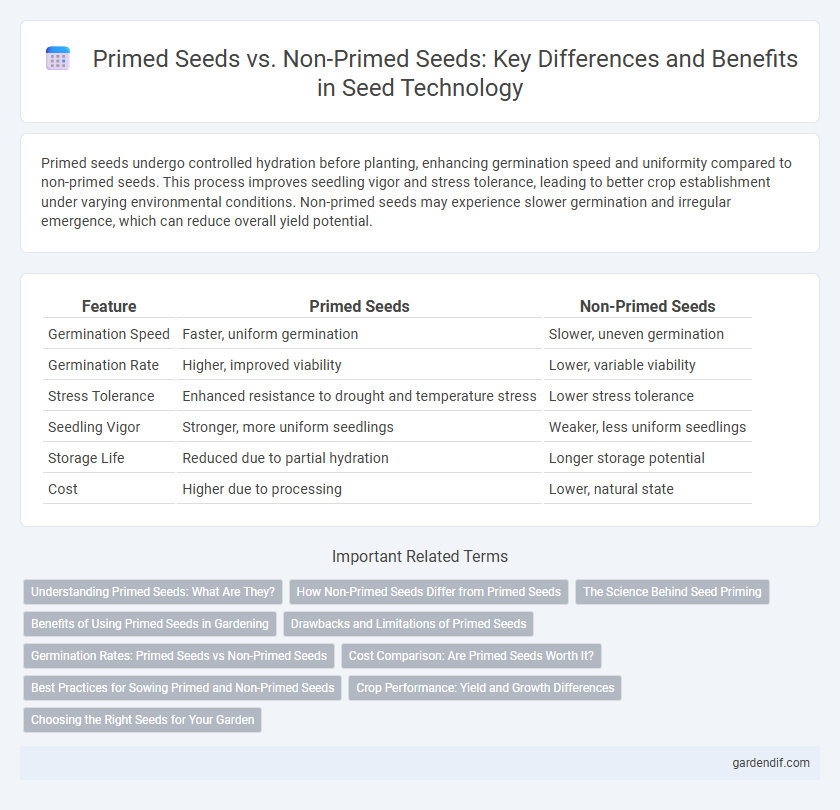
Primed seeds vs Non-primed seeds Illustration
Primed seeds undergo controlled hydration before planting, enhancing germination speed and uniformity compared to non-primed seeds. This process improves seedling vigor and stress tolerance, leading to better crop establishment under varying environmental conditions. Non-primed seeds may experience slower germination and irregular emergence, which can reduce overall yield potential.
Table of Comparison
| Feature | Primed Seeds | Non-Primed Seeds |
|---|---|---|
| Germination Speed | Faster, uniform germination | Slower, uneven germination |
| Germination Rate | Higher, improved viability | Lower, variable viability |
| Stress Tolerance | Enhanced resistance to drought and temperature stress | Lower stress tolerance |
| Seedling Vigor | Stronger, more uniform seedlings | Weaker, less uniform seedlings |
| Storage Life | Reduced due to partial hydration | Longer storage potential |
| Cost | Higher due to processing | Lower, natural state |
Understanding Primed Seeds: What Are They?
Primed seeds undergo a controlled hydration process that initiates germination without allowing radicle emergence, resulting in faster and more uniform seedling growth compared to non-primed seeds. This technique enhances seed vigor, improves stress tolerance, and increases overall crop yield potential. Primed seeds are particularly valuable in agriculture for optimizing germination rates under suboptimal environmental conditions.
How Non-Primed Seeds Differ from Primed Seeds
Non-primed seeds retain their natural dormancy period, resulting in slower and less uniform germination compared to primed seeds, which undergo pre-sowing treatment to accelerate metabolic processes. Primed seeds exhibit enhanced germination rates and increased seedling vigor due to controlled hydration and metabolic activation prior to planting. In contrast, non-primed seeds often face variable field conditions that can delay germination and reduce crop establishment efficiency.
The Science Behind Seed Priming
Seed priming enhances germination by initiating metabolic processes without radicle emergence, improving water uptake and enzyme activation. Primed seeds exhibit faster and more uniform sprouting due to controlled imbibition, which optimizes cellular repair and energy metabolism. Scientific studies confirm that priming reduces dormancy and increases stress tolerance, leading to improved seedling vigor compared to non-primed seeds.
Benefits of Using Primed Seeds in Gardening
Primed seeds offer faster germination rates and more uniform seedling emergence compared to non-primed seeds, improving overall crop establishment in gardening. These seeds undergo controlled hydration, enhancing metabolic processes that lead to stronger, more vigorous plants and better resistance to environmental stresses. Using primed seeds can reduce seed waste and improve garden productivity by ensuring higher germination success and early growth performance.
Drawbacks and Limitations of Primed Seeds
Primed seeds often have reduced shelf life due to their partial hydration, which makes them more susceptible to damage during storage and handling. The priming process can also increase the risk of fungal infections if not managed under strict sterile conditions. Additionally, primed seeds may have limited adaptability to varied environmental conditions compared to non-primed seeds, potentially reducing their performance in unpredictable field conditions.
Germination Rates: Primed Seeds vs Non-Primed Seeds
Primed seeds exhibit significantly higher germination rates compared to non-primed seeds due to enhanced metabolic activation during the priming process. This treatment reduces germination time and improves uniformity, resulting in faster seedling emergence and better crop establishment. Non-primed seeds often show delayed and inconsistent germination, impacting overall plant vigor and yield potential.
Cost Comparison: Are Primed Seeds Worth It?
Primed seeds often cost 10-30% more than non-primed seeds due to the additional treatment processes enhancing germination speed and uniformity. While the upfront investment is higher, farmers benefit from increased crop yields and reduced seed wastage, offsetting initial expenses. Evaluating factors like crop type, climate conditions, and market prices determines whether the superior performance of primed seeds justifies their cost.
Best Practices for Sowing Primed and Non-Primed Seeds
Primed seeds exhibit enhanced germination rates and uniform seedling emergence compared to non-primed seeds, making them ideal for precision sowing practices. Optimal sowing depth for primed seeds ranges between 1.5 to 2 times their diameter to prevent moisture stress and ensure robust root development, whereas non-primed seeds require slightly deeper placement to secure adequate moisture absorption. Maintaining consistent soil moisture and temperature conditions during germination significantly improves the establishment success of both seed types, with primed seeds generally demanding more precise environmental control.
Crop Performance: Yield and Growth Differences
Primed seeds exhibit enhanced crop performance by accelerating germination rates and uniform seedling emergence, which leads to improved yield stability and increased biomass production compared to non-primed seeds. Studies indicate that primed seeds boost enzymatic activities and nutrient uptake efficiency, resulting in robust plant growth and higher tolerance to abiotic stresses. Consequently, crops from primed seeds demonstrate significant yield advantages, including earlier maturation and greater overall productivity under variable environmental conditions.
Choosing the Right Seeds for Your Garden
Primed seeds undergo a pre-germination process that enhances uniformity and speeds up sprouting, making them ideal for gardeners seeking rapid and consistent crop establishment. Non-primed seeds retain natural dormancy and may exhibit slower, uneven germination, useful for crops requiring staggered growth or harsher conditions. Selecting primed or non-primed seeds depends on your garden's climate, crop type, and desired growth timeline to optimize yield and plant health.
Primed seeds vs Non-primed seeds Infographic

 gardendif.com
gardendif.com